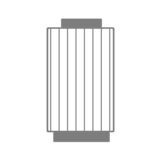Biomicron® filter element technology protects against diesel bug How diesel filters protect your engines and tanks against microbial invasions
Modern diesel engines have a very high fuel circulation quantity. This means that the fuel passes through the filters installed and only a portion is burned. The excess fuel which is conditioned by the filters is directed back into the fuel tank. The microbial load in this return flow is significantly reduced by Biomicron® technology. In this way, the microorganism load in the fuel tank is gradually reduced. This benefits the entire fuel system.
Mobile machines and commercial vehicles are subject to the toughest working conditions all over the world. Optimal diesel fuel conditioning means that your vehicles will run smoothly - at the same time, you will protect the engine and the entire drive structure from damage.
Microbe-free: strong diesel filters for a healthy fuel system
What is diesel bug?Protect your machines from the invisible danger
The consequences of diesel bug: systems contaminated with microbes are less efficient. Filters need to be changed more regularly. The maintenance requirements increase, wasting valuable resources.
But why is that the case? This microbial contamination affects tank systems, engine systems and fuel systems in machines – especially machines which have downtime periods (e. g. rental units, leasing fleets, seasonally used harvesting machines or diesel-powered emergency power generators). Petrodiesel and heavy oils are used more frequently, which plays into the hands of the diesel bug. Diesel bug is microbial contamination of diesel fuel which can be classified as classic biofouling. Bacteria and fungi assemble into a slimy film or flakes and form what is known as biofilm. This occurs on all surfaces and interfaces and damages the surrounding materials.
This is particularly relevant when conditioning fluids with fluid filters, e.g. fuel filters. Growth usually occurs here due to water ingress. The biofilm accumulates between the water and the fuel. The biofilm-forming bacteria create a slime-like film and colonise the fluid boundary layer.
How you can beat diesel bugBiomicron® diesel filter elements prevent microbiological growth
Free water in tanks encourages microbial growth in the form of bacteria, fungi and microorganisms. To tackle all of these at once, HYDAC developed an innovative filter element technology with triple protection.
Biomicron® provides 3 benefits in 1:
- Particle filtration: the fuel is kept as clean as possible with reliable particle filtration.
- Water separation: free water is efficiently separated to prevent the biofilm from spreading.
- Self-protection against microbial growth: Fully synthetic filter materials and the two-stage element design prevent microbial infestation on the filter itself. At the same time, the entire fuel system, including the tank, is conditioned.
How does the filter element technology work?
Separation mechanisms, such as inertia, diffusion, electrostatics and adhesion forces in the filter element trap the microorganisms settled in the fuel tank. The Biomicron® technology disrupts the cell metabolism, preventing microbiological growth. The two-stage element structure has a coalescing effect and builds up a hydrophobic barrier for water separation. Biomicron® is available in different filtration ratings (5, 7, 10, 30 µm).
HYDAC solutions
HYDAC HDP Diesel Precare
Reliable pre-filtration for your fuel: our HDP protects vehicle manufacturers and operators from operating malfunctions, failures and expensive service calls. With the discharge plug & play solution, it dewaters your fuel system independently of the operator and fully automatically during suction-side operation (HDP HighTech). It's also available as an operator-dependent solution (HDP BestCost). Designed as an absorbent pre-filter, the HDP protects all pumps and fuel system components from water and contamination.
HYDAC HDM Diesel Maincare
High contamination retention capacity, compact size and environmentally friendly disposal - the HDM cup filter system meets all these market requirements. Reliably filters your diesel and biofuel in the main flow. The HDM easily achieves cleanliness classes of 12/9/6, even when there are engine vibrations and load changes. In addition to the standard series, we develop custom main filter modules on request.
HYDAC Dieselmicron®
The Dieselmicron® filter element offers water separation irrespective of the contamination level along with excellent particle separation. A two-stage design makes this possible. Fully synthetic filter media allow high contamination retention capacities and steady coalescence. In a second step, the enlarged water droplets are reliably separated by the hydrophobic barrier layer on the strainer tube.
Caution: diesel bug forms hereThere is no need to panic. HYDAC diesel filters can protect your systems.
The consequences of diesel bug are devastating - many machines are affected by it, but it's often not detected in time. That's why we'd like to show you typical applications where you should expect diesel bug. What they all have in common is longer downtimes without operation - this provides the ideal breeding ground for microorganisms.
Your advantages HYDAC diesel filters against diesel bug
FAQ
What is meant by diesel bug?
The term diesel bug refers to the microbial contamination of diesel fuel and can be classified as classic biofouling. Microorganisms grow on surfaces and damage the materials. A slime-like film or flakes of different organisms, such as bacteria and fungi, is formed. The biofilm formed grows on all surfaces and interfaces.
The filter surface becomes clogged by the biofilm. The result: the differential pressure increases and the fuel becomes more corrosive. The growth on the interface between the water and fuel increases when water enters the fuel system. A slime-like film forms, varying in thickness. Biofilm is caused by bacteria that populate the fluid boundary layer and feed from nutrients in the fuel. The organisms survive even under such extreme environmental conditions due to the biofilm, because it forms a protection against mechanical stress. The film is often irregular in formation, creating aerobic and anaerobic zones. This creates a habitat for a wide variety of organisms and stimulates the exchange of genes between bacteria. The colony quickly adapts to new conditions and becomes increasingly resistant to biocides. This leads to bacteria in a biofilm being more capable of surviving and more resistant to external stress. Furthermore, diesel bug increases the fuel's acid number and leads to stronger corrosive attacks on components.
How does diesel bug form?
Diesel bug arises when biofilm-producing bacteria adhere to a surface such as the surface of a filter element. This involves individual bacteria adhering to the surface. Driving forces of this attraction between the bacteria are: Van der Waals forces, electrostatic attraction, the formation of hydrogen bonds and other physicochemical processes. These forces are also major factors responsible for the formation and cohesion of the matrix structure. The matrix formation gives rise to the characteristic properties and typical appearance of a biofilm. For a stable matrix to form, biofilm-forming bacteria must colonise a surface. Initially, they do this by spreading out across the entire surface side by side. Once they have populated the entire area, the organisms begin to grow on top of each other in multiple layers.
Extracellular polymer substances (EPS) are crucial for the cohesion of this multi-layer matrix. These substances are biopolymers that surround organisms. They originate in the organisms themselves, as they are metabolic products of bacteria or remains of dead organisms. They are composed of polysaccharides, proteins, glycoproteins, glycolipids, extracellular DNA and other nucleic acids. The biopolymers surround the individual bacterial cells, holding them together to form a firm, three-dimensional, heterogeneous compound structure. This is what makes up the biofilm. It has the appearance of slime. The biofilm holds the microorganisms together and enables a stable attachment to a surface. This structure provides the organisms with excellent protection against external influences. The only processes that occur inside the EPS structure are diffusion and convection processes, to supply the bacteria cells with substrates. The heterogeneous structure enables convection flows. In addition, the EPS themselves serve as sources of nitrogen, carbon, and phosphate. In spite of all this, there is a limit to how thick a biofilm can become. This is because as the thickness of the film increases, there is a lack of oxygen or substrate in places. The consequence: the organisms die and parts of the biofilm detach. Shear forces generated by fluid flows wear away the upper layers. These processes combined bring about a balance between growth and erosion of the biofilm.
What are diesel bug organisms?
Diesel bug organisms are environmental germs which live in water, air and soil.
Microorganisms have an exponentially high growth rate. This means that diesel bug progresses rapidly from initial infection to damage to machinery and fuel filters.
Typical diesel bug organisms are:
- Bacteria: Bacillus subtilis, Bacillus licheniformis, Pseudomonas aeruginosa
- Fungi: Hormoconis resinae
- Yeasts: Yarrowia tropicalis
How does diesel bug become noticeable?
Diesel bug can be spotted with the following signs:
- Unpleasant, putrid odour
- Cloudy fuel
- Fuel discolouration (yellow, green, brown)
- Slimy sedimentation in the fuel
- Slimy residue on filters
- Slimy residue in parts that convey fuel
What are the consequences of diesel bug?
The consequences of diesel bug are enormous where fuel consumption is concerned. It can lead to severe damage in metallic components. Microorganisms dissolve and increase corrosion in metals. The effects of this type of corrosion on metallic container walls can be explained with the example of a fuel tank.
Material degradation in the metal causes indentations at certain points. This has consequences for the components which come into contact with the biofilm. Another problem is the acidification of the fuel caused by the metabolic products of the microorganisms. These consist of acids and free radicals that support the chemical processes of oxidation and hydrolysis in the fuel. This causes the acidity of the diesel to increase to an unacceptable level in a matter of days. When biofouling occurs in fuel systems, the fuel lines and filters become clogged.
A particular problem is that when the filter becomes clogged this is not always a gradual process. Acute filter blockages can also occur if the biomass is sucked into the fuel tank. This results in the flow rate dropping severely and the differential pressure increasing. This means that the combustion engine is no longer sufficiently supplied with fuel. As a result, the engine will no longer start or severe damage will occur to machine components during operation (e.g. cavitation damage in the low-pressure pumps and high-pressure pumps). The free bacterial structures can lead to classic biofouling on the filter surface - with the same far-reaching consequences.


